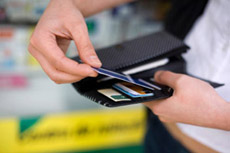Consumer Debt - Secured and Unsecured Types
Consumer debt is money owed as a result of buying services and goods. These items don’t bring profit and are consumed. Unlike mortgages, the interest payments on consumer debt are not tax-deductible.
Consumer debt allows borrowers to pay their ongoing expenses (rent, phone and electricity bills), buy goods, and go on vacation without saving. Debt can be grouped into two main categories – non-revolving such as personal and car loans and revolving like lines of credit and credit cards. Credit cards are issued by banks, credit unions, credit card companies, and other financial institutions. They work like a line of credit, and cardholders can charge purchases up to their credit limit. Borrowers with excellent credit, stable job, and high income are offered credit cards with a higher limit than those with a seasonal income and tarnished credit score. Credit cards come with a grace period or interest-free period that varies from one issuer to another. It is between 19 and 55 days. Interest is assessed after the grace period is over. Credit card issuers offer different cards, such as secured cards, airmiles cards, and low interest cards. Credit lines are also a type of revolving debt. Lines of credit are extended to individual borrowers, companies, and governments. They come with a maximum balance, and borrowers are allowed to borrow up to the maximum specified in the agreement. The amount of credit that credit card issuers extend depends on the borrower’s credit score, liabilities, and assets. There are personal and business lines of credit and home equity credit lines.

Non-revolving Credit
Financial institutions also offer it in the form of auto, payday, and installment loans. Auto or car loans are extended to borrowers for the purchase of a vehicle. Payday loans are a type of short-term borrowing instrument. Lenders offer small loans that come with a very high interest rate. It is usually cash-strapped individuals who apply with payday lenders. Installment loans are paid back over a specified period of time and in equal-sized payments.
Categories
Loans can be grouped into several categories – conventional, closed-end, and open-end. Conventional loans are conforming meaning that they meet Fannie and Freddie qualifications. A closed-ended loan is a type of borrowing instrument whereby you cannot borrow again once you pay it off. Borrowers should apply for a new loan once they repay the balance. There are different types of closed-end loans, including student and car loans. Open-ended loans are actually revolving credit (credit lines and credit cards).
Some chain and local businesses also offer credit to clients. It can be in the form of store financing or tab at the restaurant or coffee house. This type of credit was more common in the past.
Consumer debt can be expensive, depending on the interest rate. Car loans, for example, come with a rate of 5 to 10 percent. The rate of interest can skyrocket if the borrower has a tarnished credit score. Loan providers offer rates of 20 to 25 percent to applicants with bad credit. This increases the cost of the car to be financed.
Loans are also grouped into secured and unsecured. Borrowers who apply for a secured loan should offer collateral in the form of real estate, jewelry, vehicle, etc. Unsecured loans are offered with a higher rate of interest because collateral is not required. Lenders can pursue legal action or penalize you, but they cannot take your house or car. Financial institutions usually offer unsecured loans to trustworthy and creditworthy clients.
Related Articles
Loans for Borrowers with Money Problems
Bad credit loans are offered to borrowers with financial problems, poor payment history, delinquencies, bankruptcies, arrears, and missed payments. Private lenders and other financial organizations offer financing to people with poor scores, rating, and history. Features Lenders offer two types of...
Unsecured Loans for Salaried and Self-Employed Professionals
Unsecured loans are offered to trustworthy customers with a good payment and credit history. There are income, age, and other requirements to qualify. Applicants should be of legal age, and financial institutions request a photo ID, driver’s license, passport or another document to prove this. The...
Secured Loans Types and Benefits
A secured loan can take different forms – mortgage, non-recourse loan, title and secured car loans, and pawnbroker loans. The main difference between unsecured and secured debt is that the latter is backed by some valuable asset, known as collateral. There are different types of collateral...
Types of Secured and Unsecured Personal Loans
Personal loans are offered to individual borrowers rather than companies and corporations. Financial institutions such as commercial banks, credit card companies, savings and loan associations, and credit unions offer financing. Loans come in the form of unsecured and secured debt. Loan TypesThe...
